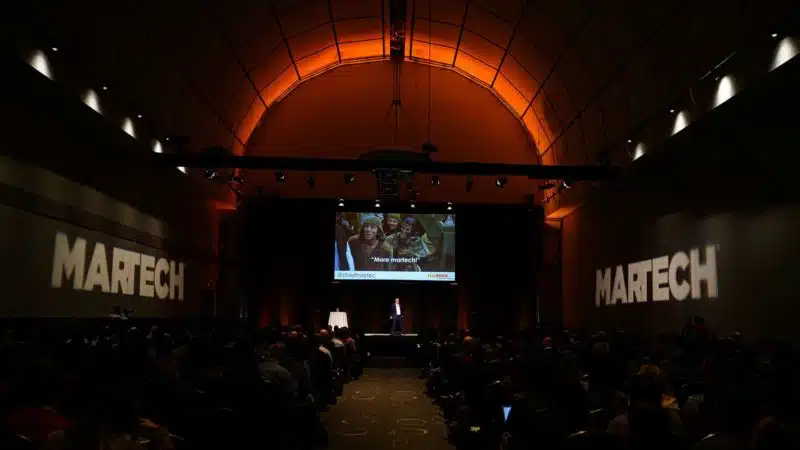How to get the most out of first-party data with email marketing campaigns
Email marketing can help brands move away from third-party data.
Virtually every digital marketer knows third-party cookies are going away. The changes in consumer privacy legislation, and the large brands adapting to it, have many scratching their heads, wondering which strategies will help them navigate these developments.
“Lots of brands and agencies are worried about the implications of Google announcing that they will be doing away with third-party cookies support for their Chrome browser,” said Cory LaGrange, Director of Digital Strategy at marketing agency emfluence, in his presentation at our MarTech conference. “That’s potentially huge for a number of different reasons.”
He added, “If the foundation of your program for marketing and advertising communications as a whole is not sound, you’re going to be at the beck and whim of these platforms and technologies every year.”
Marketers relying on third-party cookies will have a difficult time adjusting to this new era of privacy. And the longer it takes brands to move to a first-party strategy, the more control Google and others will have over their data.
Fortunately, many marketers have a replacement in mind — a campaign medium that can help collect actionable first-party data: Email.
Replace third-party data with email marketing
“As digital marketers, we’ve leaned on them [third-party cookies] for such a long time,” said LaGrange. “We allow third-party cookies to do so much of the heavy lifting when it comes to our targeting, our prospecting, and our lead generation.”
The overreliance on third-party data in the marketing industry is astounding. Citing a study from Epsilon and Phronesis Partners, LaGrange pointed out that 79% of digital advertisers were either very reliant or moderately reliant on third-party cookies.
“That goes to show us that we have to stop being so reliant on third-party cookies and data,” said LaGrange. “It doesn’t allow us to be in control, so we’re left doing things like begging users to interact with us in the ways that are now compliant.”
Email marketing can help address these issues by collecting consumer information directly instead of relying on third-party cookies.
“Let’s say this website has an email address and that website has an email address,” he said. “If they have a commingled experience, they can start to tie some of those interaction points together and really get an idea of what consumers are doing where previously they would have had to do that with a third-party cookie.”
Contact customers the way they prefer
By and large, consumers prefer to interact with marketers via email, according to data from SmarterHQ and Smart Insights. The second highest communication preface was social media. Yet marketers can often place too great an emphasis on social and end up neglecting email.

“You would be shocked to know the lower priority that brands have on email and the emphasis that they place on social media because it’s a quick win,” said LaGrange. “They want that immediate lead in the funnel.”
It’s true that email lead turnarounds can be slower than social media. But marketing to consumers in the way they want has more potential to turn them into engaged subscribers. Prioritizing this first-party data collection through email can help markers gain actionable consumer insights.
Create effective first-party data segments
Once marketers shift to email strategies, they can break the first-party data they gather into actionable segments. These can include form fills, call clicks, or other unique activities.
“These are things like activity of your subscribers or activity of customers in your ecom platform,” LaGrange said. “Those things are first-party data points and those are the things that we want to start building campaigns and journeys around.”
Collecting this first-party data through email doesn’t have to be like pulling teeth, which is often the case with third-party collection strategies. In fact, email campaigns are a great way to listen to customers.
“People really want that two-way conversation,” said LaGrange. “They want to provide you with preferences and their thoughts in their proclivities.”
He added, “But they really want that to result in a crafted experience. They want to know that the information they’re giving you is being activated in a way that’s beneficial for both of you.”
Craft engaging emails customers want
“Once you’ve really honed in on these email segments, you can finally craft and send emails that your customers want,” said LaGrange. “Build that relationship and build emails based on the things they really want to see.”
Personalizing emails based on consumer first-party data has the potential to improve engagement. The data they consent to provide can also offer marketers many opportunities to build higher levels of trust.
“All of these are different types of motivations and things that we should be considering when we’re building an email program,” said LaGrange. “But that can only happen when we take the time to invest in developing our lists and segmenting based on that information that they’ve trusted us with.”
Watch the full presentation from our MarTech conference here (free registration required).

Contributing authors are invited to create content for MarTech and are chosen for their expertise and contribution to the search community. Our contributors work under the oversight of the editorial staff and contributions are checked for quality and relevance to our readers. MarTech is owned by Semrush. Contributor was not asked to make any direct or indirect mentions of Semrush. The opinions they express are their own.
Related stories